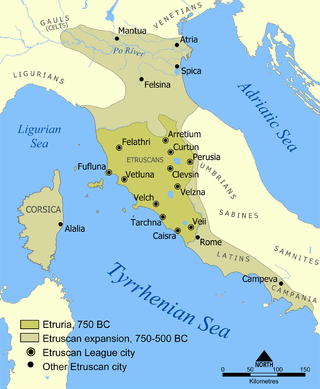
The Etruscan civilization was developed by a people of Etruria in ancient Italy with a common language and culture who formed a federation of city-states. After conquering adjacent lands, its territory covered, at its greatest extent, roughly what is now Tuscany, western Umbria, and northern Lazio, as well as what are now the Po Valley, Emilia-Romagna, south-eastern Lombardy, southern Veneto, and western Campania.

Veii was an important ancient Etruscan city situated on the southern limits of Etruria and 16 km (9.9 mi) north-northwest of Rome, Italy. It now lies in Isola Farnese, in the comune of Rome. Many other sites associated with and in the city-state of Veii are in Formello, immediately to the north. Formello is named after the drainage channels that were first created by the Veians.

Falerii is a village in the municipality of Fabrica di Roma in the Province of Viterbo, Italy. Its name is better known for two nearby ancient cities, Falerii Veteres and Falerii Novi.

Falisci is the ancient Roman exonym for an Italic tribe who lived in what is now northern Lazio, on the Etruscan side of the Tiber River. They spoke an Italic language, Faliscan, closely akin to Latin. Originally a sovereign state, politically and socially they supported the Etruscans, joining the Etruscan League. This conviction and affiliation led to their ultimate near destruction and total subjugation by Rome.

Grave goods, in archaeology and anthropology, are items buried along with a body.
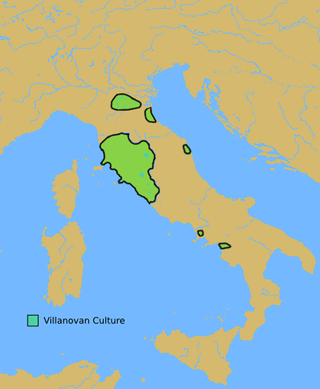
The Villanovan culture, regarded as the earliest phase of the Etruscan civilization, was the earliest Iron Age culture of Italy. It directly followed the Bronze Age Proto-Villanovan culture which branched off from the Urnfield culture of Central Europe. The name derives from the locality of Villanova, a fraction of the municipality of Castenaso in the Metropolitan City of Bologna where, between 1853 and 1855, Giovanni Gozzadini found the remains of a necropolis, bringing to light 193 tombs, of which there were 179 cremations and 14 inhumations.
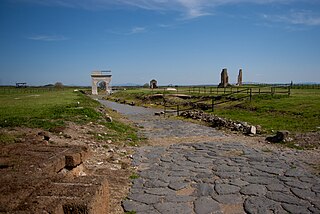
Vulci or Volci was a rich Etruscan city in what is now northern Lazio, central Italy.
Timothy William Potter was a prominent archaeologist of ancient Italy, as well as of Roman Britain, best known for his focus on landscape archaeology.

The Tomb of the Roaring Lions is an archaeological site at the ancient city of Veii, Italy. It is best known for its well-preserved fresco paintings of four feline-like creatures, believed by archaeologists to depict lions. The tomb is believed to be one of the oldest painted tombs in the western Mediterranean, dating back to 690 BCE. The discovery of the Tomb allowed archaeologists a greater insight into funerary practices amongst the Etruscan people, while providing insight into art movements around this period of time. The fresco paintings on the wall of the tomb are a product of advances in trade that allowed artists in Veii to be exposed to art making practices and styles of drawing originating from different cultures, in particular geometric art movements in Greece. The lions were originally assumed to be caricatures of lions – created by artists who had most likely never seen the real animal in flesh before.

Etruscan history is the written record of Etruscan civilization compiled mainly by Greek and Roman authors. Apart from their inscriptions, from which information mainly of a sociological character can be extracted, the Etruscans left no surviving history of their own, nor is there any mention in the Roman authors that any was ever written. Remnants of Etruscan writings are almost exclusively concerned with religion.

Etruscan cities were a group of ancient settlements that shared a common Etruscan language and culture, even though they were independent city-states. They flourished over a large part of the northern half of Italy starting from the Iron Age, and in some cases reached a substantial level of wealth and power. They were eventually assimilated first by Italics in the south, then by Celts in the north and finally in Etruria itself by the growing Roman Republic.

Etruscan art was produced by the Etruscan civilization in central Italy between the 10th and 1st centuries BC. From around 750 BC it was heavily influenced by Greek art, which was imported by the Etruscans, but always retained distinct characteristics. Particularly strong in this tradition were figurative sculpture in terracotta, wall-painting and metalworking especially in bronze. Jewellery and engraved gems of high quality were produced.

The Etruscans, like the contemporary cultures of Ancient Greece and Ancient Rome had a persistent military tradition. In addition to marking the rank and power of certain individuals in Etruscan culture, warfare was a considerable economic boon to Etruscan civilization. Like many ancient societies, the Etruscans conducted campaigns during summer months; raiding neighboring areas, attempting to gain territory and combating piracy as a means of acquiring valuable resources such as land, prestige goods and slaves. It is also likely individuals taken in battle would be ransomed back to their families and clans at high cost. Prisoners could also potentially be sacrificed on tombs to honor fallen leaders of Etruscan society, not unlike the sacrifices made by Achilles for Patroclus.

In antiquity, several theses were elaborated on the origin of the Etruscans from the 5th century BC, when the Etruscan civilization had been already established for several centuries in its territories, that can be summarized into three main hypotheses. The first is the autochthonous development in situ out of the Villanovan culture, as claimed by the Greek historian Dionysius of Halicarnassus who described the Etruscans as indigenous people who had always lived in Etruria. The second is a migration from the Aegean sea, as claimed by two Greek historians: Herodotus, who described them as a group of immigrants from Lydia in Anatolia, and Hellanicus of Lesbos who claimed that the Tyrrhenians were the Pelasgians originally from Thessaly, Greece, who entered Italy at the head of the Adriatic sea in Northern Italy. The third hypotheses was reported by Livy and Pliny the Elder, and puts the Etruscans in the context of the Rhaetian people to the north and other populations living in the Alps.
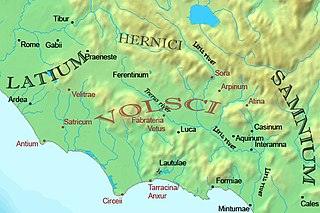
The Latins, sometimes known as the Latials or Latians, were an Italic tribe which included the early inhabitants of the city of Rome. From about 1000 BC, the Latins inhabited the small region known to the Romans as Old Latium, that is, the area between the river Tiber and the promontory of Mount Circeo 100 km (62 mi) southeast of Rome. Following the Roman expansion, the Latins spread into the Latium adiectum, inhabited by Osco-Umbrian peoples.

Civita Castellana is a town and comune in the province of Viterbo, 65 kilometres (40 mi) north of Rome.

The Monterozzi necropolis is an Etruscan necropolis on a hill east of Tarquinia in Lazio, Italy. The necropolis has about 6,000 graves, the oldest of which dates to the 7th century BC. About 200 of the tomb chambers are decorated with frescos.
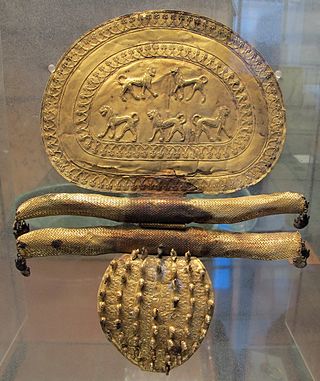
The tomb known as the Regolini-Galassi tomb is one of the wealthiest Etruscan family tombs in Caere, an ancient city in Italy approximately 50–60 kilometres (31–37 mi) north-northwest of Rome. The tomb dates to between 680/675-650 BC. Based on the evidence of the tomb's architecture and its contents, it was built by a wealthy family of Caere. The grave goods included with the two decedents included bronze cauldrons and gold jewellery of Etruscan origin in the Oriental style. The tomb was discovered in 1836 in modern-day Cerveteri in an undisturbed condition and named after the excavators, general Vincenzo Galassi and the archpriest of Cerveteri, Alessandro Regolini. Both of these men had previous experience opening and excavating tombs in the area of Caere.
Jean MacIntosh Turfa is an American archaeologist and authority on the Etruscan civilization.
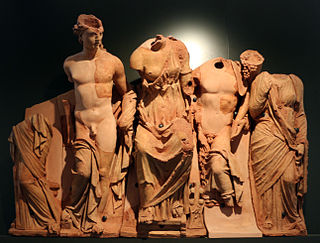
Etruscan sculpture was one of the most important artistic expressions of the Etruscan people, who inhabited the regions of Northern Italy and Central Italy between about the 9th century BC and the 1st century BC. Etruscan art was largely a derivation of Greek art, although developed with many characteristics of its own. Given the almost total lack of Etruscan written documents, a problem compounded by the paucity of information on their language—still largely undeciphered—it is in their art that the keys to the reconstruction of their history are to be found, although Greek and Roman chronicles are also of great help. Like its culture in general, Etruscan sculpture has many obscure aspects for scholars, being the subject of controversy and forcing them to propose their interpretations always tentatively, but the consensus is that it was part of the most important and original legacy of Italian art and even contributed significantly to the initial formation of the artistic traditions of ancient Rome. The view of Etruscan sculpture as a homogeneous whole is erroneous, there being important variations, both regional and temporal.





















